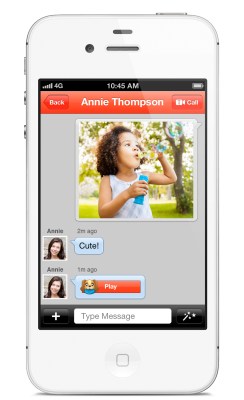This spring, Tango raised $40 million in a Series C round and announced plans to expand beyond its original focus of enabling video calls between mobile users. In fact, it’s no longer accurate to call Tango a “video chat service” as we once did — it’s now a social platform. The company has been slowly inching in this direction with the launch of video messaging and, more recently, text messaging. Today, it goes even further with the debut of photo-sharing features and its first in-app game, which Tango users can play together in real-time.
According to Tango co-founder Eric Setton, the company has benefitted from the attention apps like Skype and features like Apple’s FaceTime receive, saying that every time video calling was mentioned, it helped to raise Tango’s profile. That being said, the company felt like it could do more. “If I look at mobile social communication, there’s no question in my mind that’s bigger than just video calling,” he says. “It’s an exciting evolution and opportunity for us,” Setton says about moving beyond calls. “It’s a disruptive market. You need to understand mobile, and not so many people do yet.”
 Setton explains that while Tango is taking a step toward a merger of social and communication with the new release, they didn’t want to “bury users in functionality.” So the first new feature in today’s release expands upon the previously launched text-messaging option, also allowing photo-sharing between Tango users. Another addition sees more branded “Tango Surprises” — the cutesy animations with which users can decorate their video call screens. The new ones come from Sesame Street, Strawberry Shortcake, and Care Bears. Setton says a third of Tango calls are between family members, like parents or grandparents phoning the kids, so these brands make sense.
Setton explains that while Tango is taking a step toward a merger of social and communication with the new release, they didn’t want to “bury users in functionality.” So the first new feature in today’s release expands upon the previously launched text-messaging option, also allowing photo-sharing between Tango users. Another addition sees more branded “Tango Surprises” — the cutesy animations with which users can decorate their video call screens. The new ones come from Sesame Street, Strawberry Shortcake, and Care Bears. Setton says a third of Tango calls are between family members, like parents or grandparents phoning the kids, so these brands make sense.
More interesting, however, is the in-app game. Squash is a turn-based, “whack-a-mole” type of game, which two users play during their call. Many-to-many game play may be an option in the future. And Setton says that Tango will release more games by the end of the year. Because Tango is a free app, all monetization is through these value-add features, such as animations, greeting cards, and now, gaming. This first game will be free, but future games may be paid. There’s also the possibility that Tango will accept third-party submissions down the road — if Apple is OK with that, of course. Ninety to 95% of Tango’s user base is mobile-only (iOS, Android, Windows Phone), so monetizing through gaming on the desktop only wouldn’t make much sense.
Tango’s user base of 65 million now extends across 212 countries and continues to grow. After the company launched text messaging earlier this year, it took only four weeks to convert 20% of its daily average users to adopt the feature. As for how many daily actives or monthly actives there actually are, Setton declined to say. But in April, he had told us that there were then 45 million users, 10% who used it daily and 44% who used it monthly. Those proportions are still the same, he says.
While 65 million is a number any early-stage startup would lust after, it’s still far short of Skype’s 250 million monthly connected users (not to mention its 600 million+ registered users). Tango, in other words, still has a long way to go before it will be worth the $8.5 billion Microsoft paid for Skype. But it’s still growing. Now it’s time to see if going more social instead of focusing only on the utility of communication is the right choice for the company.

